DIETARY LAWS - KASHRUT.
| BIBLICAL LAWS |
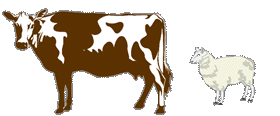 
|
ANIMALS. |
| The rule for animals that may be eaten is: And every beast that parts the hoof, and has the hoof cloven into two, and chews the cud among the beasts, that you may eat.3. Even if an animal lacks only one of these characteristics it can not be eaten. Those animals that chew the cud, eat vegetation; and animals with split hooves are usually peaceful animals. Hence the two specifications rule out all animals that prey on others. |

|
FISH. |
| For fish in fresh or sea water the rule is: These shall you eat of all that are in the waters; whatever has fins and scales in the waters, in the seas, and in the rivers, those may you eat.4. This rule has sometimes caused problems as some scales and fins are rather rudimentary and so there has been considerable debate about sturgeon and whether it is permitted to eat caviar. (You should be so lucky !) |
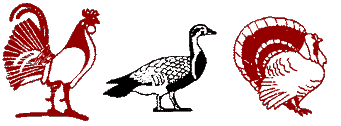 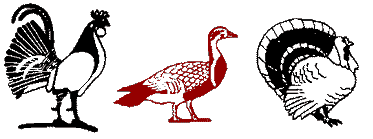
|
BIRDS. |
| Instead of giving a general rule for birds, the Bible lists the names of the species which are not permitted to be eaten.5. The Mishnah states that these forbidden birds seize their food in their claws and have an extra talon,6. meaning that these are birds of prey. The problem of relying on a list of names is that for several of these names, we are not sure of their exact modern equivalents. And secondly. Is it right that when any new species is found, that it is automatically kosher because it was not on the original list of those specifically forbidden. This caused a problem with American turkeys. Some Rabbis approved their suitability for eating, but a few did not. |

|
REMAINING CREATURES. |
| Almost any other creature apart from those listed above is not permitted to be eaten. All reptiles, amphibians and invertebrate animals are forbidden to us. In the latter category are included shellfish. The only other creatures that the Bible permits are a small group of locusts. 7. (However, I have never met any Jew who claimed to have eaten one.)
|
BIBLICAL LAWS. |
ANIMALS, BIRDS, FISH, and OTHER CREATURES. ) |
(9.) Lev chap 3 especially v. 17 and Lev. 17, 23-25 (10.) Deut. 14, 21; Lev 17, 15, etc. (11.) Ex. 22, 30; Lev. 17, 15 & Lev. 22, 8. (12.) Lev. 7, 26; Lev 17, 10-14; Deut. 12, 16 & 23; Deut. 15 ,23. (13.) Ex. 23, 19; Ex 34, 26 & Deut. 14, 21. |
REASONS FOR BIBLICAL LAWS.
The Bible says we should not eat the prohibited foods because they are  tamei, unclean.14. Instead we should sanctify ourselves and be holy … for I am the Lord your God who brought you out of the land of Egypt, to be your God, you shall therefore be holy. 15. It goes on to say these laws make a distinction between unclean and clean.16. Such foods are described as a
tamei, unclean.14. Instead we should sanctify ourselves and be holy … for I am the Lord your God who brought you out of the land of Egypt, to be your God, you shall therefore be holy. 15. It goes on to say these laws make a distinction between unclean and clean.16. Such foods are described as a  to'evah. an abomination 17. and
to'evah. an abomination 17. and  shekets, a detestable thing.18. These words are very strong language, and by themselves are sufficient to explain why Jews have observed the dietary laws over the ages.
shekets, a detestable thing.18. These words are very strong language, and by themselves are sufficient to explain why Jews have observed the dietary laws over the ages.
However, this does not explain why they are there in the first place. The following are some of the views which have been expressed:
- THESE ARE CHUKIM, statutes contained in the Torah and because they come from God have to be obeyed. A chok is a law that is given without a reason having to be given. As Samson Raphael Hirsch said: would it not be enough for you that God…[has not given] you the right to partake of these foods.19.
- HEALTH REASONS. Maimonides, who was a doctor, said: All the food which the Torah has forbidden us to eat have some bad or damaging effect on the body.20. While Abarbanel took the opposite view saying that if that were so, the Torah would be no better than a minor medical book, and pointed out that the Torah does not forbid plants that are harmful or poisonous.21. Yet it was a fact that In warm climates like those where Judaism originated, both pork and shellfish were notorious as sources of food poisoning. Before refrigeration was widespread, English folklore recommending that shellfish should only be eaten when there was an 'R' in the month. (winter months)
- RITUAL CLEANLINESS. The word
 tamei, is also used to describe ritual uncleanness,22. which prevented a person entering a holy place. The Jewish people, described as a kingdom of priests and a holy nation,23. were required to keep themselves ritually pure and holy.
tamei, is also used to describe ritual uncleanness,22. which prevented a person entering a holy place. The Jewish people, described as a kingdom of priests and a holy nation,23. were required to keep themselves ritually pure and holy.
- EASTERN VIEW OF HOLINESS. Kaufmann Kohler said: The animals forbidden in the Mosaic law are almost the same as are prohibited to the priests and the saints in the ancient Hindu, Babylonian and Egyptian laws.24.
- DISTINCTIVENESS. Not only did they make a distinction between unclean and clean,25. but they served to make a distinction between Jew and non-Jew. These laws have undoubtedly helped to preserve Jewish identity and even Jewish survival over the centuries.
- ETHICAL IDEALS. Aristeas (c. 100 BCE) said that not eating birds of prey teaches us not to prey on others.26.
- HOLINESS IN LIFE. These laws emphasise that religion should enter into all aspects of life, and that we should be able to control our appetites and raise ourselves above the rest of the animal kingdom.
(14.) Lev. 11, 4,ff & Deut 14, 7, ff. (15.) Lev 11, 44-45. (16.) Lev. 11, 47. (17.) Deut. 14, 3. (18) Lev. 11, 10, ff. (19.) Horeb 448. (20.) Guide for Perplexed 3, 48. (21.) Commentary on Leviticus. (22.) Num. 9, 6, ff etc. (23.) Ex. 19, 6. (24.) JE 4, 599, citing "Laws of Manu" and "Laws of Apastamba" (25.) Lev. 11, 47. (26.) Letter of Aristeas 146-7.
| POST- BIBLICAL LAWS |
SHECHITAH
The Biblical dietary laws by themselves were not enough to teach the people what to do with their food. When the Bible states that we can eat meat but that we should not eat the blood of an animal, how do we ensure that we obey these rules? From early times they must have developed practical methods to avoid eating blood; but it was not until the Mishnah (c. 200 CE) that these practices were codified into law. However, Jews had been eating meat for a long time before the Mishnah, so most probably the Mishnah was describing old existing practices. We know, for example, that at least 400 years before this Daniel and his three friends asked permission not to eat the Babylonian meat so as not to be defiled.27. Was this because of the way that the animals were killed or because some was from forbidden species? Probably the former, because they could have eaten beef, mutton, etc.
Daniel 1, 8ff.
ORIGIN OF BLOOD LAW.
The law against eating blood was less of a dietary law than it was a prohibition of a pagan custom. The Torah explains the prohibition against consuming blood by saying: For the blood is the life.28. When early humans saw a wounded person or animal bleeding to death they saw them weaken as their blood drained away. So they assumed that the blood contained the life. It was likely that the Israelites also knew of tribes who ceremonially ate the blood of their victims to gain power or of an animal in order to gain their strength, etc. It was this pagan practice that was being forbidden, hence the punishment of anyone who did this was to be cut off from his people.29. The Bible does not mention the ethical objection of cannibalism which underlay it. Possibly this is because of the strong prohibition against murder in the Ten Commandments. The expression of calling someone blood-thirsty is much later.
(28.) Deut 12, 23 & Lev 17, 14. (29.) Lev. 17, 14.
METHOD OF SLAUGHTER.
In the stories in the early part of Genesis, which many understand to be symbolic legends, we read that Adam was told that was told: You may surely eat of any tree in the garden. 30. Some interpret this to mean that in the ideal world (the Garden of Eden) we should be vegetarians. Noah, however was told: Every living creature shall be food for you just like all the green vegetation which I have given you.31. This is taken to mean that in the real world man may eat meat. (The prohibitions against eating various species came later. See ANIMALS, FISH and BIRDS. ) The following verse in Genesis, which spoke of not taking and eating a limb of a living animal, was taken by later Rabbis as meaning that we should take care not to cause undue pain to animals.32. So we find that Rabbis condemned the practice of hunting animals for pleasure,33. and of course any animals killed in this way would be t'refah. Although any killing of animals for food is abhorrent to some people, the method insisted on by the Rabbis was intended to be as humane as possible.
Shechitah is carried out by a trained and qualified slaughterer known as a shochet. In order to remove the maximum of blood the animal's throat is cut with a sharp knife. Although this may sound and appear brutal, this is in fact quick and painless to the animal. By cutting off the blood supply, the animal loses consciousness virtually instantaneously. The knife used has to be very sharp and without any nicks in the blade. It has to be inspected before each cut. Any damage to the blade might lead to the animal's flesh being torn and so making it t'refah. But this also ensures that the animal feels nothing. Human beings may cut themselves with something very sharp and not feel pain for some while, the same is true for animals. Some years ago scientific tests were carried which showed that animals killed in this way suffered no pain. Electrodes were fixed to animals to see if the brain registered any reaction to pain and none was found. If a Shochet does not follow these strict rules properly the animal is not regarded as kasher and the slaughterhouse suffers a financial loss. This provides an added incentive to care properly for the animal.
(30.) Gen. 2, 16. (31.) Gen. 9, 3. (32.) Shabbat 128b and Maimonides: Guide For The Perplexed 3, 48. (33.) Responsum of Ezekiel Landau, Yoreh De'ah, no. 10.
MEAT IN THE KITCHEN.
Once the meat has been brought home there is further treatment to remove the blood. The meat is washed and soaked in water and then salted and allowed to stand in order that blood should drain out. Very detailed instructions exist for food preparation and a specialist web site should provide more details. One example of this is that eggs are often cracked into a basin before use to make sure that there is not a spot of blood in them.
 |
 |
 |
 |
 |
 |
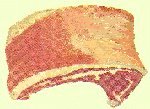 |
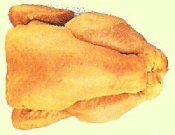 |
 |
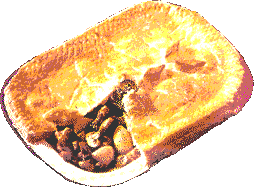 |

The Rabbis felt that the rule not to boil a kid in the milk of its mother must be very important as it occurs three times. (see OTHER BIBLICAL LAWS [No. 6.] ) Following the principle of putting a fence round the Law34. they wanted to ensure that there was not the slightest chance of someone buying a kid from one stall in the market and some of its mother's milk from another and using them together in cooking. So by the second century CE, they had decreed that no milk could be used in meat cookery.35. It is quite likely that the rule was one of those decreed in the 1st or 2nd cent BCE by the Pharisees, because they introduced a great many observances received from their fathers, which were not written in the Law of Moses.36.
This fence-building process continued in later ages. Meat and milk products were not allowed to be served at the same meal. And because milk is easier to digest than meat, in order to prevent them mixing in the stomach, after eating meat a certain time has to elapse before you can eat a food containing a milk product. (Various authorities require different times, ranging from one to six hours 36.) To avoid a tiny scrap of one sort of food mixing with the other because it was sticking to crockery, cutlery or in cooking utensils, it was decreed necessary that everyone needed to have separate meat and milk plates, milk and meat crockery, meat and milk cooking pots, and meat and milk dish cloths, etc. Very often these are colour-coded for ease of recognition. In more recent times it has led to separate sinks for washing-up and separate fridges for storing food. All this burdensome series of laws and recommendations grew from not boiling a kid in the milk of it's mother. Truly this is a mountain hanging from a hair.
Beside the two categories of meat and milk foods, often spoken of by Ashkenazi Jews as fleishig and milchig respectively, there is a third category which is neither meat nor milk, known as parev or parve. Eggs, fish, vegetables and fruit are all parev.
(34.) Avot, 1, 1. (35.) Hullin 8, 1. (36.) Josephus, Antiquities, 13, 10, #6. (37.) Yoreh De'ah 89 in Turei Zahav.
ORIGIN OF MEAT & MILK LAW.
When first promulgated, the law about boiling a kid in it's mothers milk was not a dietary law at all. Instead, it was one of the laws against practising pagan worship. Maimonides (12th cent CE) wrote: most probably it is somehow connected with idolatry, forming part of the service, or being used on some festivals of the heathens.38. He made this suggestion because he noted that two out of the three times the law is mentioned 39. it seems to be connected with festival observances. He said that it was as if the law was saying: When you come before me on your festivals, do not boil your food in the manner that the heathens do.38.
Maimonides put forward this theory as the best reason for the prohibition.40. It was not until eight centuries later that hard evidence was found to back up this theory. Ugaritic texts were found at Ras Shamra in Syria, which described the boiling of a kid in this way as a pagan fertility rite.41. However, by the 20th century, the custom of separating meat and milk foods had become so much a part of Jewish dietary customs, that many Jews could not bring themselves to alter it after so many centuries. For many of the more orthodox it was now regarded as part of the Oral Torah and had almost as much authority as if it had been decreed at Sinai. In fact many believe that it was implied at Mount Sinai by the verses about boiling a kid.
(38.) Guide for the Perplexed, 3, 48. (39.) Ex. 23, 17 - 19. & Ex. 34, 23 - 26. (40.) Ibid. (41.) E. J. vol 6, 44.
JEWISH FOOD.
After reading all these laws, a non-Jew might wonder with so many restrictions, how does a Jew enjoy his food. The simple answer is very much. There is a wide range of Jewish dishes which are very tasty. Jews in different parts of the world developed their own local recipes. Ashkenazi Jewish food is probably the best known. This originated in central Europe. Sephardi Jews from the Mediterranean area have their own dishes. But within these groups there is considerable variation. Arguments among Ashkenazim have persisted on whether one should put sugar into Gefulte (stuffed) Fish. While Sephardi Jews from Morocco or Iraq, for instance, have very different cuisine. For those interested, several good cookery books have appeared. For those non-Jews who want to try Jewish food, the best advice is to try to get yourself invited to a Jewish wedding or a Barmitsvah. Failing that, drop into a Jewish Beigel Bake and sample some filled beigels. Enjoy!
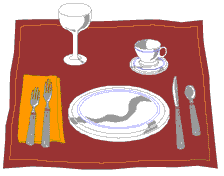
 (pronounced Kasher with the emphasis on the last syllable, or as Askenazi Jews pronounce it Kosher with emphasis on the beginning) means fit or ritually permitted. The opposite of this is
(pronounced Kasher with the emphasis on the last syllable, or as Askenazi Jews pronounce it Kosher with emphasis on the beginning) means fit or ritually permitted. The opposite of this is  T'refah which literally means torn and refers to any animal killed by another animal;2. but now it is used colloquially by Jews to refer to any food which is not kasher.
T'refah which literally means torn and refers to any animal killed by another animal;2. but now it is used colloquially by Jews to refer to any food which is not kasher.